Establishing Acceptance Limits for Uniformity of Dosage Units: Part 1
The Uniformity of Dosage Units test is used to evaluate content uniformity or weight variation or dosage forms such as tablets and capsules. The author introduces two different acceptance value limits (n = 10 and 30) in this article.
ImageFlow/shutterstock.com
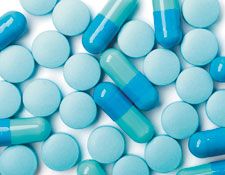
Submitted: Jan. 4, 2016.
Accepted: Feb. 21, 2016.
Abstract
In Uniformity of Dosage Units (UDU) test, the single limit for acceptance value (AV) of not more than (NMT) 15 cannot discriminate between the conforming and nonconforming lots of products. Because the coverage ranges for distributions of AV data in stages 1 and 2 are not the same, meeting the compendial limit in stage 2 may lead to releasing the product lots with relatively high nonconforming rates. Establishing the working limit for each of the two stages is the most justified approach to prevent such false release. Upon complete construction of the AV distributions (n = 10 in stage 1 and n = 30 in stage 2), the critical AV numbers (i.e., at locations with a high percentage of coverage such as 95%) are determined. Using such established limits, a company quality unit can guarantee that none of the poor quality lots are released to the market.
CLICK TABLE TO ENLARGE Table I: Uniformity of Dosage Units: Test acceptance criteria.

Uniformity of Dosage Units test (1) is employed for evaluation of dosage units such as tablets and capsules in terms of content uniformity or weight variation as appropriate. There is a threshold limit between content uniformity (for dosage units containing < 25 mg or < 25 %) and weight variation (for dosage units containing ≥ 25 mg and ≥ 25% of API; except for sugar-coated tablets requiring content uniformity). The test descriptions with respect to test acceptance criteria and reference value (M) determination criteria are summarized in Tables I and II, respectively.
CLICK TABLE TO ENLARGE Table II: Uniformity of Dosage Units: Reference value determination criteria.

This article provides the tabulated test descriptions rather than in text so that the readers can see the comparative views of the two stages. The views include having a common acceptance value (AV) limit of not more than (NMT) 15 and an implication that meeting stage 1 criteria ensures that no dosage unit will exceed the range between 0.75M and 1.25M, although it is not mentioned in stage 1. Furthermore, the readers will be able to imagine how the AV data for different sample sizes are distributed and subsequently understand why two different limits are established in this article.
Process benchmarking
It is necessary to determine the acceptable process benchmark in terms of, for example, the minimum process capability index (lot CpK) as the baseline for the working AV acceptance limits. Figure 1 illustrates a lot distribution of simulated dosage units (within the range of 85% and 115% of label claim) where the lot CpK is 1.33 and the lot conforming rate is 100%. The two process characteristics will underlie the acceptance limit establishment.
Figure 1: 100% conforming rate of dosage units at lot CpK = 1.33.
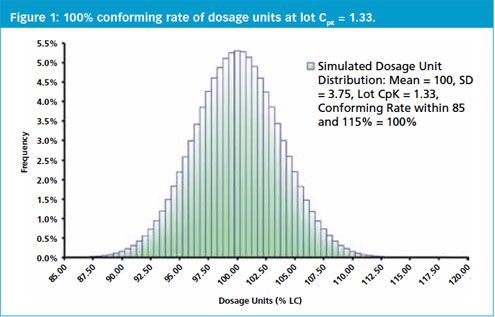
With the same benchmark (lot CpK = 1.33), another simulation test is conducted using the Bergum method (2-4) for generating the probability of meeting UDU test. Figure 2 illustrates the distribution of the simulated probability results (n = 30; from validation sampling plan 30/70 for UDU). In the figure, the coverage for probability results not less than (NLT) 90% is approximately 95%. Such 95% coverage will also confirm that the minimum validation sample size n = 30 is justified. For n = 70, or the other validation sampling plans such as 60/140, all the coverages will be 100%.
Figure 2: Distribution of “probability of meeting Uniformity of Dosage Units (UDU)” results.
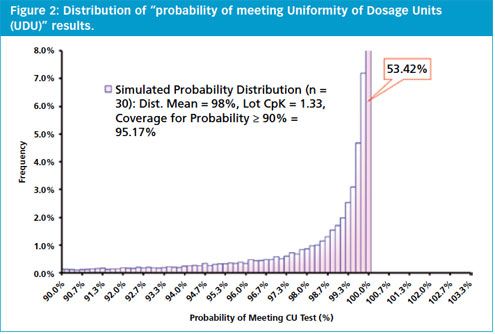
From the two simulations, it may be concluded that, under the same lot CpK (1.33), the minimum 90% probability results with 95% coverage (Figure 2, n = 30) is equivalent to the minimum 100% conforming rate (Figure 1). Such an equivalency will be applied in the next step (establishing AV acceptance limits).'
Note that “lot CpK” or “population CpK” is addressed in this article to differentiate from “sample CpK,” which is computed using sample data.
Construction of AV distribution
A pool of normal data with population mean and standard deviation of 100 and 3.75, respectively, can be simulated following the method described in the Appendix section (simulation testing of AV distribution and Table A) using MS Excel function “=NORM.INV(RAND(),100,3.75).” Appendix Equations 4 and 5 can be substituted on Excel spreadsheets (Tables A and III) with the data such as n = 10, μ = 100, σ = 3.75, upper limit (UL) = 115 and lower limit (LL) = 85. In the “thick line” border, since AV = 8.25 (x-axis), then chi-square variable = 7.35, cumulative probability density will be 39.97%, and then the non-cumulative one 4.67%.
Table III: Acceptance value (AV) vs. probability data (n = 10): the upper part of MS Excel spreadsheet in Table A.
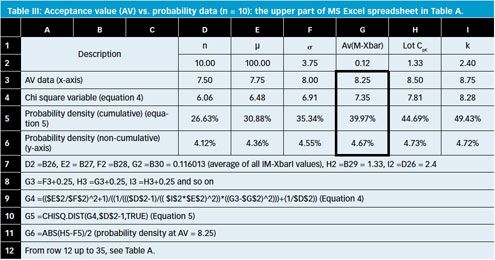
Note: The completed MS Excel files (Figures 1-4, where Figures 3 and 4 have already included those formulae in Tables III and A) can be downloaded from the bottom of this article or requested directly from cpramote2000@yahoo.com. The files provide a shortcut to understanding of the AV distribution construction.
If n = 30 and the other parameters are kept as is, in the ‘thick line’ border, then chi-square variable = 24.33, cumulative probability density will be 28.77%, and the non-cumulative one 3.70% (see Table IV).
Table IV: Acceptance value (AV) vs. probability data (n = 30) (MS Excel spreadsheet).

To construct an AV distribution, first generate AV data, in fact the computed AV data calculated (2-4) from the generated normal data with population mean = 100 and population standard deviation = 3.75 in the range required (see the file for download) and plot the AV data (x-axis, sky blue row 3 in Table III) vs. probability density results (y-axis, pale yellow row 6 in Table III) using MS Excel’s Chart Tool. The density results in MS Excel are the cumulative data, so the non-cumulative ones are to be computed as demonstrated in Table III (row 6). However, it should be noted that Tables III and IV are intended for demonstration of calculation only, a full degree of calculation can be seen in the file for download. The AV distributions constructed are based on lot CpK fixed at 1.33 and illustrated in Figures 3 and 4. The integrated view of the two distributions can be seen in Figure 5.
Figure 5: Acceptance value (AV) distributions: Theory (n = 10 and 30). USP is United States Pharmacopeia.
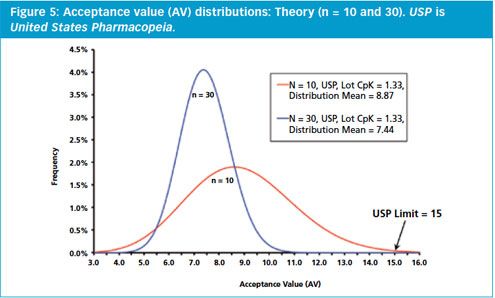
Establishing AV acceptance limits
When using the control chart principle where the upper warning limit (UWL) is equal to μ+2σ (approximately 95% coverage) in which μ and σ are the distribution mean and standard deviation respectively, the AV acceptance limit is the adjusted number of UWL such that the percentage coverage is approximately 95%. For example, in stage 1 (Figure 3, n = 10), the UWL is equal to distribution mean plus 2 distribution standard deviations or 8.87+2x2.11 = 13.09, which is adjusted to 12.5 so that the coverage is approximately 95%. In stage 2 (Figure 4, n = 30), the UWL is 7.44+2x0.98 = 9.4 and adjusted to 9.1 where the coverage is approximately 95%. Such distribution means and standard deviations, as well as how to determine the 95%
coverage, can be estimated using the weighted average, root mean square deviation, and data ranking principles, respectively (also available in the file for download).
Figure 3: Acceptance value (AV) distributions: Simulation vs. theory (n = 10, k = 2.4, United States Pharmacopeia).
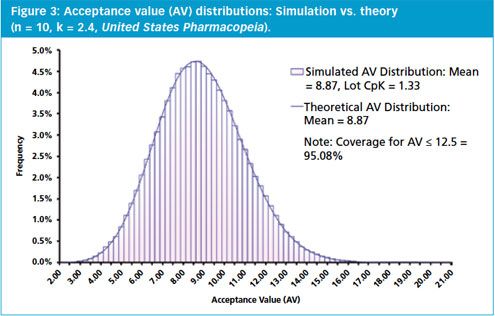
From the simulations involved, it may be concluded again that, under the same lot CpK (1.33), the maximum AV result at 12.5 (Figure 3, n = 10) or 9.1 (Figure 4, n = 30) is equivalent to the minimum 90% probability results (Figure 2, n = 30). The equivalency is based on the same 95% coverages of the three figures. Such an inter-relationship including the distribution mean values (adjusted to be the AV average limits) is the minimum baseline for establishing the acceptance limits in this article. Summarized in Table V is the proposal for the established AV acceptance limits.
Figure 4: Acceptance value (AV) distributions: Simulation vs. theory (n = 30, k = 2.0, United States Pharmacopeia).
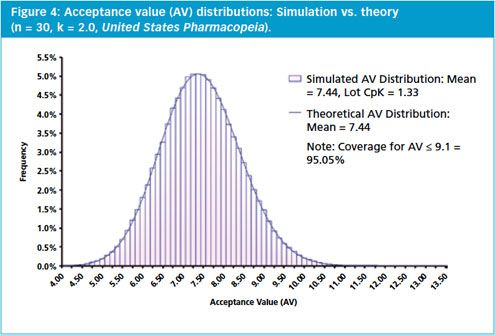
Discussion
The Appendix details the full statistical background. The following discussion includes the application use of the acceptance limits and Appendix Table A, split from Table III, due to its complicated functions.
Figure 6: CpK distributions (n = 10, Lot CpK = 1.33).
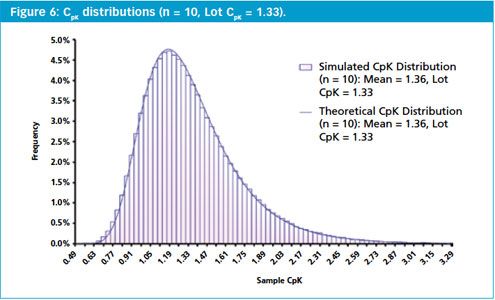
The mean of AV distribution for a certain sample size will correlate with the corresponding lot CpK where both parameters (the distribution mean and lot CpK) may be estimated by the averages of the individual results (for CpK, see reference 5 and Figures 6 and 7). It is, therefore, recommended that the averages of all accumulated AV data are to be computed and reported in, say, the annual product review (APR) or continued process verification (CPV) reports to demonstrate that the average values are NMT the corresponding limits (i.e., confirming that the lot CpK is not below 1.33), which is the process benchmark.
Figure 7: CpK distributions (n = 30, Lot CpK = 1.33).
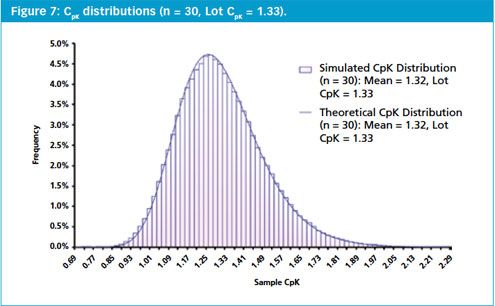
The following examples are given for the readers’ understanding.
Example one (a real case): In addition to trend analysis of the AV data (Tolperisone tablet 50 mg, 20 batches, all of the data having sample size n = 10) in an APR report using control chart technique in a pharmaceutical company, evaluation of the AV data through determining the process performance (CpK) was also carried out (Table VI).
Table VI: Evaluation of historical acceptance value (AV) data (20 batches). NMT is not more than. USP is United States Pharmacopeia.

Example two (a worst-case scenario): In a scenario of Roxithromycin tablet 150 mg, 30 batches, the AV data are available as both sample sizes n = 10 and n = 30. The first 10 units were assayed and evaluated, followed by evaluation of 20 additional units and 30 units. The AV data (n = 10 & 30) and the probability of meeting UDU test (n = 30) were computed. The probability results for smaller samples such as n = 10 were too biased (i.e., too low), hence, calculation for n = 10 was not performed. Part of the data was selected in Table VII.
Table VII: Evaluation of historical acceptance value (AV) data (30 batches). NMT is not more than. USP is United States Pharmacopeia. Example
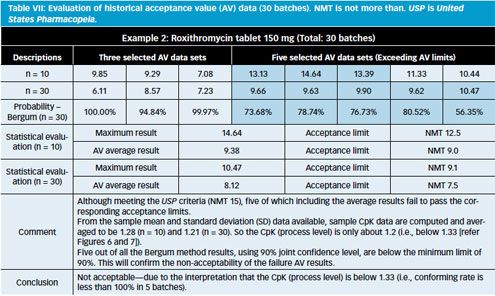
For process validation sampling plans using n = 30/70 or 60/140 (i.e., testing and evaluating 30 or 60 units in stage 1 and 70 or 140 units in stage 2), the AV distributions will provide the corresponding acceptance limits. Such distributions and how to establish the acceptance limits will be available in Part 2 of this series.
Conclusion
The concept of AV distribution is the same as that of statistical sampling distributions. With normal approximation, establishing AV acceptance limit using control chart technique can be easily done. The critical AV number is approximately equal to μ+2σ (about 95% coverage), where μ is the distribution mean and σ is the distribution standard deviation.
Table V: Proposed acceptance value (AV) acceptance limits. NMT is not more than.

See Table V for the acceptance limits for routine batch AV results. The simulation tests conducted are successful because the plotted data properly fit to the theoretical solid-line distributions. The results confirm that the probability density function (pdf) formula introduced in this article is valid. Due to the fact that different patterns and coverage ranges of AV distributions are governed by different sample sizes, two different AV acceptance limits (n = 10 and 30) are established and introduced in this article. Justification of all the established limits has already been confirmed by the Bergum method (Figure 2 and Table VII).
Download the corresponding excel worksheets here:AV Simulation N10Normality SimulationCU Probability SimulationAV Simulation N30
Acknowledgement
The author is grateful to the reviewer for comments beneficial to revision of this article.
References
1. USP, General Chapter <905> “Uniformity of Dosage Units,” USP-NF (US Pharmacopeial Convention, Rockville, MD, 2014).
2. J.S. Bergum and H. Li, Pharmaceutical Technology, 31 (10) 90-100 (2007).
3. P. Cholayudth, Journal of Validation Technology, 14 (2) 62-72 (2008).
4. ASTM Standard Number E2810--11: Standard Practice for Demonstrating Capability to Comply with the Test for Uniformity of Dosage Units, October 2011.
5. P. Cholayudth, Journal of Validation Technology, 19 (4) (2013).
6. A.T. McKay, Journal of Royal Statistics Society, 95 (4) 695-698 (1932).
About the Author
Pramote Cholayudth is the managing director of the Professional Conference Center, Ltd., 6/756 Number One Complex, Bangkok-Ram 2 Road, Pravate District, Bangkok 10250, Thailand, fax 662.740.9586, cpramote2000@yahoo.com.
Article Details
Pharmaceutical Technology
Vol. 40, No. 12
Pages: 34–43
Citation
When referring to this article, please cite it as P. Cholayudth, "Establishing Acceptance Limits for Uniformity of Dosage Units: Part 1” Pharmaceutical Technology 40 (12) 2016.

Full Tolerance Coverage Method for Assessing Uniformity of Dosage Units with Large Sample Sizes
March 10th 2025The ‘full tolerance coverage method’ is introduced as a coverage estimation approach for assessing the uniformity of dosage units from large sample sizes, ensuring that no dosage unit exceeds the specification range.
Drug Solutions Podcast: Applying Appropriate Analytics to Drug Development
March 26th 2024In this episode of the Drug Solutions Podcast, Jan Bekker, Vice President of Business Development, Commercial and Technical Operations at BioCina, discusses the latest analytical tools and their applications in the drug development market.
Inspiration Over Desperation: Accurant Biotech CEO Talks Leadership, Innovation, and Motivation
March 4th 2025Xiao-Yan Cai, PhD, shares insights into her leadership style, the importance of motivation in the workplace, and how she balances repetition with innovation, discussing how hobbies and resilience uniquely shape her professional approach, emphasizing the value of perseverance and preparation in both science and life.
Specification Equivalence—A Practical Approach
December 30th 2024In this first of a four-part series, the authors provide an introduction to a practical approach for establishing specification equivalence. The regulatory basis and compliance examples from FDA observations and warning letters are included to support the need for an effective process.